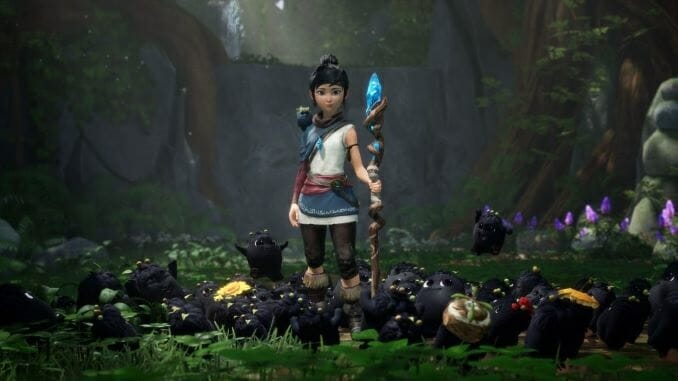The Generic Kena: Bridge of Spirits Can’t Restore Life to Well-Worn Videogame Clichés

In a sense, Kena: Bridge of Spirits longs for something meditative. Superficially, the game is about restoring a dead world, not combating an alive one. You enter the game’s central community as an outsider, but try to help them on their own terms. However, Kena, both the character and her game, cannot outrun traditional verbs of play. Though the videogame makes claims to harmony and balance, it is still about control.
Kena opens in medias res, as our title character enters an abandoned village. All the inhabitants are dead, though the game avoids such language. Kena is a spirit guide, the “bridge” between death and life, so she must find the ghosts of the villagers and help them to the beyond. This means, of course, doing videogame shit. You’ll shoot arrows at targets and switches, throw bombs to open up passageways or rearrange puzzle elements, as well as fight big bosses with well signaled weak spots.
The game’s immediate fatal flaw is its genericness. The puzzles can be moderately amusing or clever, but fit into predictable configurations. Every design decision feels either ripped directly from another game or “good game design” YouTube essays and blog posts. Once you know the game’s tools of little helpers (a la Pikmin) plus arrows and bombs (a la Zelda), you know what the entire rest of the game will be made out of. Admittedly, that would not be true for children, who must take up a large portion of Kena’s target audience. It is difficult to avoid novelty when doing something for the first time. Still, a hypothetical child would be better off playing Sable, Ratchet and Clank, or virtually any Zelda. Kena offers nothing that its inspirations don’t already have, with more verve, bite, and impact.
The game’s varied aesthetic inspirations feel similarly inert. Comparisons to contemporary Disney or Pixar abound, but films like Brave and Moana at least have the pretense of a fleshed out culture. They gesture at a setting that might exist beyond the film’s runtime. Not Kena. It calls prominent in-game locations “The Mountain” and “The Village,” thereby rendering all of its world into pure allegory. Kena herself discusses a backstory, but it feels like fodder for a sequel rather than important character context. There is nothing wrong with reduced scale—it is somewhat refreshing that you are saving souls rather than worlds—but Kena generalizes so viciously that its story lacks any particularities. Fundamental questions like “what is the village’s culture?” or “what is the world outside of it like?” are left by the wayside. Furthermore, the game only gestures at why a spirit needs to be saved until after you have completed their quest. Then the game launches into a short film length info dump about the spirit’s former life. This sudden invocation of narrative renders any emotional stakes weightless.
-

-

-

-

-

-

-

-

-

-

-

-

-

-

-

-

-

-

-

-

-

-

-

-

-

-

-

-

-

-

-

-

-

-

-

-

-

-

-

-








































